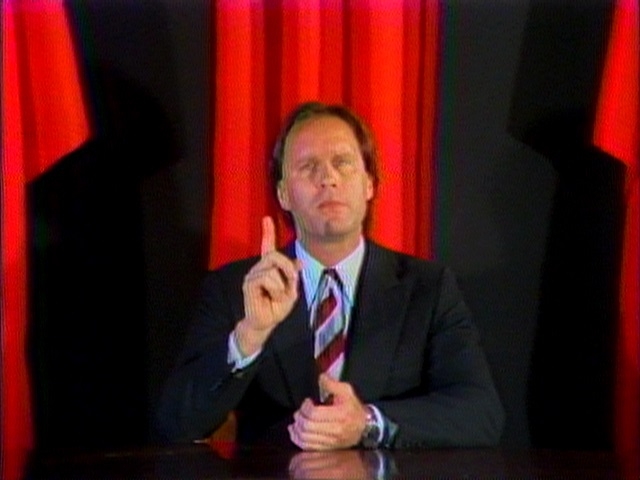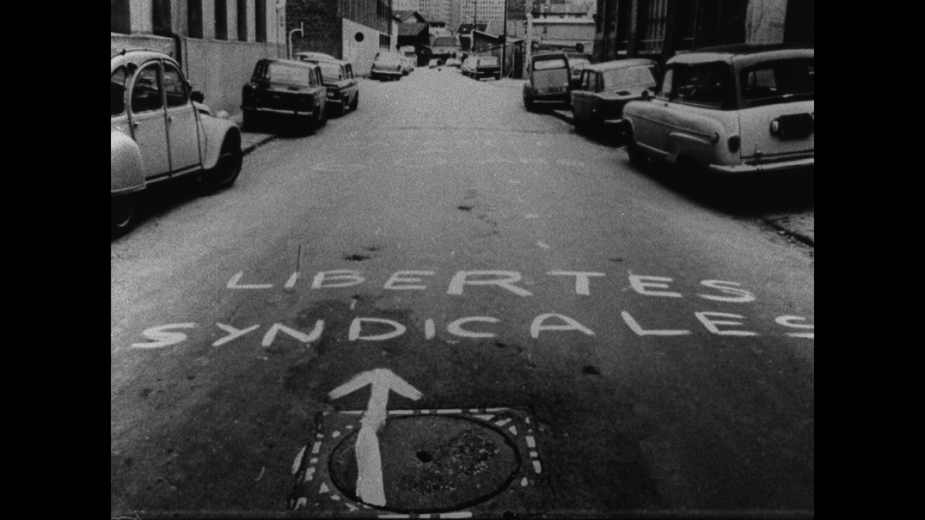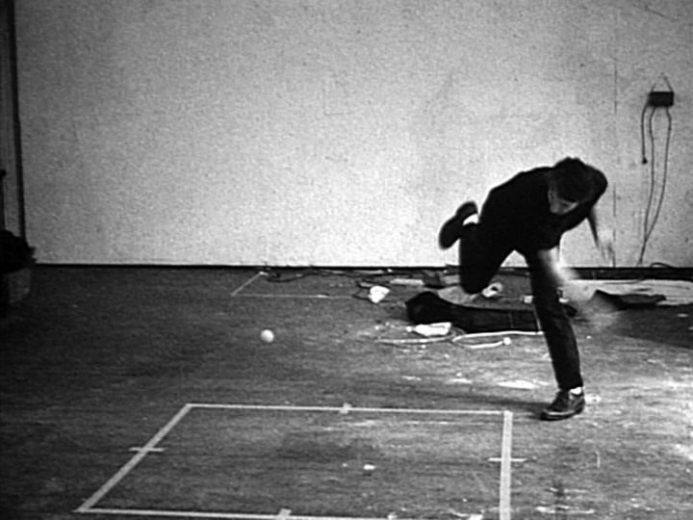
VIDEOART IN AUGUST #3
Guest Curator: Tom van Vliet
The 3 selected works, Let’s Call it Love by Breda Beban; Hostage: The Bachar tapes by Walid Ra’ad; and FIASCO by Janet Riedel, Katja Pratschke and Gusztav Hamos, have in common a fundamental search, an investigation; the amazement, the astonishment, the existing or non existing borderlines between fiction and reality, the representation of amazement and of what is important. Against the background of war in Serbia, Lebanon and Stalinist Hungary, an investigation about the perception of truth is presented.
Tom van Vliet initiated in 1982 the renowned World Wide Video Festival and directed the festival until 2004. From 1984 till 1996, he was also director of the Kijkhuis, center of contemporary art in Leiden, The Netherlands. He curated exhibitions by Tony Oursler, Nan Hoover, Madelon Hooykaas & Elsa Stansfield, Nam June Paik, Keith Piper, Klaus vom Bruch, Gary Hill, Marie-Jo Lafontaine, Walid Ra’ad, Darya von Berner and the exhibition Double Vision on the aesthetic and conceptual aspects of the multiple image. He commissioned and produced several video installations by, among others, Nalini Malani, Michal Rovner and Eder Santos and curated exhibitions for the Stedelijk Museum, Reina Sofia Museum, Biennale of Fukui, Paisagem de Luz and Busan Biennial. Tom van Vliet initiated a 360 degree moving image panorama and has commissioned works to various artists. He also curated a series of outdoor projections and mapping with Pipilotti Rist, General Idea, and Pablo Valbuena, among others.
Let's Call it Love, Breda Beban
7’15’’, 2000
Somebody switches on an old Garrard gramophone. The record's grooves slowly glide through the image. The person selects the last song. The needle drops into the groove and the languid first notes of a jazz classic are heard. Chet Baker starts to sing. Unavoidably you are overwhelmed by the atmosphere of melancholy that takes you with it in an indefinable desire. A desire that remains unfulfilled as the needle gets stuck halfway through the song. The record is started once more, but again this desire is shipwrecked on the cliffs of the grooves. Slowly but surely a threatening rumbling rises in the background and we discern the sound of planes flying overhead. Now the grooves of the record are replaced by fighter planes leaving deep tracks in the sky. These images of jet planes are almost as hypnotizing as the revolving record and the music's languid bass line. We see no images of horror or terror. No devastated cities, only an almost abstract ballet high in the sky. However, we can feel the merciless implications of these continuous sorties. Bombs and missiles slowly detach themselves and start on their journey down to the land far below. From the laid-back safe atmosphere where we could dream away without being threatened, we now find ourselves in the harsh reality of war. Beban takes us with her to her country of origin, Yugoslavia, where she was born in Novi Sad, one of the worst hit cities in the Kosovo war. She, like no other, feels this torn sentiment. The longing of the exile, the distance and the involvement, the disgust and compassion for the home country… what words are there to describe this? Let's Call it Love.
Breda Beban (1952–2012) is a Serbian film and video artist. Beban was born in Novi Sad and studied art in Zagreb. She moved to Britain in 1991. Between 1986 and 1994, she made films and video works collaboratively with Hrvoje Horvatic. In 1992, she was part of the exhibition Committed Visions at the Museum of Modern Art, New York. Beban's two-screen video installation titled The Most Beautiful Woman in Gucha was presented at the 2007 Venice Biennale. In 2001, she was the recipient of a Paul Hamlyn Foundation award for visual artists. In 2010, her project the Endless School was presented at the Tatton Park Biennial. Let’s Call it Love was presented in 2000 at the World Wide Video Festival, in Amsterdam.
Hostage: The Bachar tapes, Walid Ra'ad
16’17’’, 2001
Hostage: The Bachar tapes (English version) is attributed to Souheil Bachar and is about the abduction and detention in Lebanon in the 1980s and early 1990s of Western men like Terry Anderson and Terry Waite by "Islamic militants". This episode directly and indirectly consumed Lebanese, U.S., French, German, and British political and public life, and precipitated a number of high-profile political scandals like the Iran-Contra Affair in The United States. In Hostage: The Bachar tapes (English version) this crisis is examined through the testimony of Souheil Bachar, who was held hostage in Lebanon between 1983 and 1993. What is remarkable about Souheil's captivity is that he was held for three months in 1985 in the same cell as five American men: Terry Anderson, Thomas Sutherland, Benjamin Weir, Martin Jenco, and David Jacobsen. In 2000, Souheil collaborated with The Atlas Group to produce fifty-three videotapes about his captivity. Tapes#17 and #31 are the only tapes he makes available outside of Lebanon. In the tapes, Souheil addresses the cultural, textual, and sexual aspects of his detention with the Americans.
A central theme in the work of Walid Ra'ad (1967) is the war that tore apart Lebanon between 1975 and 1990. As a child he witnesses the extremely violent nature of this conflict. In 1983, Walid Ra'ad left Lebanon for New York where he applied himself to Visual & Cultural Studies. Confronted with an abundance of visual material and photographs of Beirut, he becomes fascinated by how the western world views the conflict in Lebanon. It is a view he does not recognize. He embarks on a personal project that focuses on research; research into Lebanon's history and the value of documents about that history. Conversations on this topic form an important part of his work and this is why he teaches, gives lectures and does performances. In the work of Walid Ra'ad, fiction and reality become so mixed as to be almost indistinguishable. Not just reality is important to him, but also how this reality might have been, and this is why he manipulates his material. Ra’ad is the recipient of the 2011 Hasselblad-Prize, the 2007 Alpert Award for Visual Arts, and the 2007 Deutsche Borse Photography Prize. His works have been exhibited at World Wide Video Festival in Amsterdam; Documenta 11 in Kassel, Germany; The Venice Biennale in Venice, Italy; The Whitney Biennial in New York; and The Ayloul Festival in Beirut, Lebanon, as well as other events and museums throughout North America, Europe, and the Middle East.
FIASCO - Fragments based on the novel by Imre Kertész, Janet Riedel, Katja Pratschke & Gusztav Hamos
30’, 2014
With the photonovel FIASCO - an homage to La Jetée by Chris Marker - is introduced: a nameless airport in a large, foreign yet familiar city, a man is searching for a way to survive, in a system which has condemned all those people who have not yet lost their belief in the individual freedom. FIASCO tells of a new beginning in Stalinist Budapest of the 1950's after surviving Auschwitz and Buchenwald. Confronting the perception of time, FIASCO explores the search for identity and the multiplication of one's personality under the repression of totalitarianism. Imre Kertész literary method is transformed into a visual language: by joining fragmentary elements from the past and the present, by finding traces that link experience and remembering.
Katja Pratschke (1967) is a media artist and curator. Since 2006, has organised photo film seasons with Thomas Tode and Gusztáv Hámos, with whom she has collaborated since 1998. Her films and installations have been shown at Ludwig Muzeum, Budapest (Hungary); SFMOMA, San Francisco (USA); Akademie der Künste, Berlin (Germany); and Tate Modern, London (UK). She has received various awards and Artist-in-Residence grants in Istanbul, Dhaka, Kolkata and Venice.
Gusztáv Hámos (1955) é artista multimédia e escritor. A sua prática artística inclui trabalhos em filme e vídeo, fotografia, instalações, e esculturas interativas. É também editor de diversas publicações e curador de filmes e exposições. Nascido em Budapeste, reside em Berlim desde 1979. Tem obras nas coleções do MoMA, Nova Iorque e do Centre Georges Pompidou, Paris. Na Alemanha, está nas coleções do NBK, Berlim; do ZKM. em Karlsruhe e do Kunstsammlung NRW, em Dusseldorf. Na Hungria tem trabalhos nas coleções do Ludwig Museum e C3, em Budapeste.
Gusztáv Hámos (1955) is a media artist and writer. His artistic practice includes film and video works, photography, installations, and interactive sculptures. He is also editor of various publications and curator of film and exhibitions. Gusztáv Hámos was born in Budapest, Hungary, and lives in Berlin, Germany, since 1979. His works are included in the collections of MoMA, New York; Centre Georges Pompidou, Paris; NBK, Berlin; ZKM, Karlsruhe; Kunstsammlung NRW, Düsseldorf; Ludwig Museum, Budapest; and C3, Budapest.
On the harsh nakedness of truth — the diaphanous mantle of fantasy
Eça de Queiroz in A Relíquia [The Relic], 1887
maat, Museum of Art, Architecture and Technology in a partnership with Horta Seca, producer of the festival Temps d'Images and FUSO - Festival de Videoarte Internacional de Lisboa, presents a video art program that will take place for a month in 4 sessions, every Saturdays of August.
The project has explore the theme of #truth, inspired by this iconic quote from Eça de Queiroz's book and the thought that sustains it: that fantasy often allows to transmit or reveal a truth.
Four renowned curators in the field of international video art were invited to bring to the museum a proposal for each session: Jean François-Chougnet, artistic director of FUSO and director of MUCEM; Tom van Vliet, founder of the World Wide Video Festival; Bernardette Caille, editorial director and independent curator; and Lori Zippay, executive director of Electronic Arts Intermix (USA). The screenings will be presented starting at 5pm and will be accompanied by a commentary from each curator.


